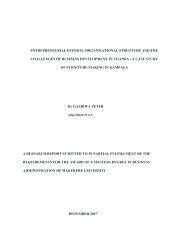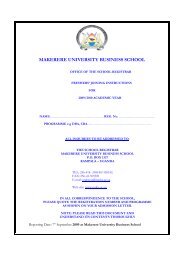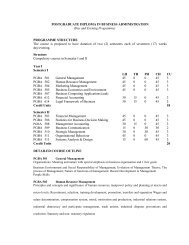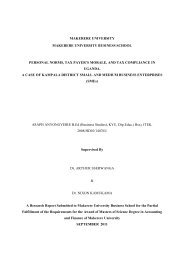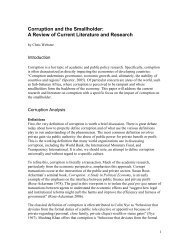13th Annual International Management Conference Proceeding
13th Annual International Management Conference Proceeding
13th Annual International Management Conference Proceeding
You also want an ePaper? Increase the reach of your titles
YUMPU automatically turns print PDFs into web optimized ePapers that Google loves.
III. SMALL AND MEDIUM ENTERPRISE (SMEs) SECTOR DEVELOPMENT<br />
The Kenya government’s commitment to foster the growth of SMEs emerged as one of the key strategies in the 1986<br />
report Economic <strong>Management</strong> for Renewed Growth. It was reinforced as a priority in the 1989 report, The Strategy<br />
for Small Enterprise Development in Kenya: Towards the Year 2000, a document that set out the mechanisms for<br />
removing constraints to growth of SME sector. In 1992, the government published the SME policy report, Sessional<br />
Paper No. 2 Small Enterprises and Jua Kali Development in Kenya. This report was reviewed in 2002, leading to a<br />
new policy framework that provided a balance focus to SME development in line with the national goals of fostering<br />
growth, employment creation, income generation, poverty reduction and industrialisation. The overall goal is to, in<br />
partnership with the public, private and development partners, create 500,000 jobs annually over the next four years.<br />
The bulk of these jobs are expected to be created in the SME sector, 88 per cent from new enterprises and 12 per cent<br />
from the growth of existing enterprises (Sessional Paper, 2004). However, in this latest sessional paper on<br />
development of SMEs, it is acknowledged that a number of constraints need to be addressed if the SME sector is to<br />
realise its full potential(Ibid). Among these are;<br />
� A deteriorating infrastructure which negatively impacts on SME competitiveness<br />
� A high cost of credit and unavailability of long-term and medium term financing<br />
� A burdensome and costly regulatory environment<br />
� An unfavourable tax regime<br />
� An inefficient legal and judicial system<br />
� Limited access to reliable market data and trade-related information and poor access to markets<br />
� Limited opportunities for international linkages and linkages with large enterprises<br />
� Scarce IT resources<br />
� Poor coordination of SME association and institutions<br />
� Inadequate access to business skills and technology<br />
� Insecurity of tenure<br />
Unlike the years before 1990, where the Government was locked up in the much discredited Schumpeter theory, that<br />
only big business can produce innovation and economic growth(IDRC 2006), the Government of Kenya has, in the<br />
last decade, shown keen interest in the development of Small and Medium Enterprises. Its effort to promote and<br />
support SMEs has been aided by assistance from donors and development partners such as the World Bank, United<br />
Nations Development Programme (UNDP), Overseas Development Agency (ODA), United States Agency for<br />
<strong>International</strong> Development (USAID), the European Union, Ford Foundation and Canadian <strong>International</strong><br />
Development Agency (CIDA) (Penderson and Kiiru 1996). SMEs are traditionally closely connected with the<br />
Kenyan management model, majority are managed by one person or family, their incomes are tiny and irregular; most<br />
compete with each other and make similar products, which they try to sell to the same markets. Profit margins are low.<br />
Under its current Economic Recovery Strategy, Kenya needs to create 500,000 jobs each year to absorb approximately<br />
half a million graduates from various tertiary academic institutions that enter the job market each year. However, due<br />
to low economic growth, rampant corruption, nepotism and demand for experience by potential employers, a majority<br />
of job market entrants remain unemployed (Mahinda, 2004). Therefore, the growth of SMEs is a needed<br />
intervention in the Kenyan economy for purposes of wealth and job creation. In 1993, for example, it grew 20%; the<br />
large-enterprise sector, on the other hand, recorded a rather sluggish 2.3% growth in the same year. The implication of<br />
these growth rates, if they continue at their present levels, is that in the foreseeable future small enterprises will employ<br />
three out of every four people looking for a job in the nonagricultural sector of the economy.<br />
The importance of this sector to the overall welfare of the population in Kenya cannot be underestimated. To illustrate<br />
this fact, a 1999 survey estimated that there are 1.3 million micro-enterprises employing 2.4 million people, two thirds<br />
of whom are in rural areas. This figures increases to 5 million people, an equivalent of 30% of Kenya's labour force,<br />
when informal businesses are included. They contribute 18% to the country's Gross Domestic Product<br />
(USAID/KENYA 2005). In addition to its importance in job creation and contribution to the GDP, the smallenterprise<br />
sector contributes 33% of the value added in manufacturing and retail trade in Kenya. (Onyango and<br />
Tomecko, unpublished). So to touch the SMEs means to question the fundaments of the Kenyan economy. The<br />
particularity of Kenyan SMEs constitutes the key argument to block a wider discussion about corporate governance<br />
among SMEs.<br />
34



